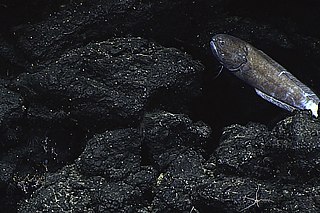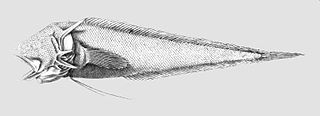Ophidiiformes is an order of ray-finned fish that includes the cusk-eels, pearlfishes, viviparous brotulas, and others. Members of this order have small heads and long slender bodies. They have either smooth scales or no scales, a long dorsal fin and an anal fin that typically runs into the caudal fin. They mostly come from the tropics and subtropics, and live in both freshwater and marine habitats, including abyssal depths. They have adopted a range of feeding methods and lifestyles, including parasitism. The majority are egg-laying, but some are viviparous.
Pearlfish are marine fish in the ray-finned fish family Carapidae. Pearlfishes inhabit the tropical waters of the Atlantic, Indian, and Pacific Oceans at depths to 2,000 m (6,600 ft), along oceanic shelves and slopes. They are slender, elongated fish with no scales, translucent bodies, and dorsal fin rays which are shorter than their anal fin rays. Adults of most species live symbiotically inside various invertebrate hosts, and some live parasitically inside sea cucumbers. The larvae are free living.

Rendahl's messmate is a pearlfish of the family Carapidae, found in the southwest Pacific Ocean around Australia and New Zealand at depths to 60 metres (200 ft). Its length is between 10 and 12 centimetres .The larvae has a long filament on its head which bears some resemblance to a siphonophore. These fish live within sponges. The specific name honours the Swedish naturalist and artist Hialmar Rendahl who collected the specimens in the Tasman Sea which were used by Gilbert Percy Whitley to describe this species.
The worm pearlfish is an eel-like fish in the family Carapidae.
Echiodon is a genus of pearlfishes, with these currently recognized species:
Eurypleuron is a genus of pearlfishes, with these currently recognized species:
Pyramodon is a genus of pearlfishes, with these currently recognized species:

Snyderidia canina is a species of pearlfish found in all tropical waters but those of the eastern Pacific Ocean, depths from 110 to 1,762 m. This species grows to a length of 26.8 cm (10.6 in). This fish is the only known species in its genus which was named in honour of the ichthyologist John Otterbein Snyder (1867-1943) for the assistance he lent to Charles Henry Gilbert on the cruise to Hawaii on which the type specimen was collected.
Alcockia is a genus in the cusk-eel family. It contains only the single species Alcockia rostrata, which is found in the Indian and western Pacific Oceans, at depths of from 2,761 to 4,040 metres. This species grows to a length of 35 centimetres (14 in) SL. The generic name Alcockia honours Alfred William Alcock (1859-1933) who was the surgeon-naturalist aboard the R.I.M.S. Investigator.
Bassogigas gillii is a species of cusk-eel found in the Indian, Pacific Ocean, and Atlantic Oceans at depths of from 637 to 2,239 metres.
Bassogigas is a genus of cusk eel from the subfamily Neobythitinae, part of the family Ophidiidae. The generic name "Bassogigas" comes from a combination of two Latin words: bassus, which means "deep" and gigas which means "giant". The species are found in the Indo-Pacific and western Atlantic Ocean.
The Australian tusk, Dannevigia tusca, is a species of cusk-eel found in the waters off of the Great Australian Bight occasionally to Bass Strait at depths from 115 to 400 m. This species grows to 56 cm (22 in) in total length. It is the only known member of its genus and the generic name honours Harold Christian Dannevig (1860-1914) who was the Director of Fisheries for the Australian government, who collected type specimen and who was later lost at sea when the fisheries research vessel he was working on vanished without a trace.

The needletooth cusk is a species of cusk-eel found in the Indian and the western Pacific Ocean where it occurs at depths of 1,000 to 1,750 metres. This species grows to a length of 21.5 centimetres (8.5 in) SL. It is the only known species of its genus The generic name is a compound of the Greek epetrion meaning "needle" and odous meaning "tooth", while the specific name honours the English ichthyologist Norman Bertram “Freddy” Marshall (1915-1996) who worked on deep sea fishes as the British Museum.
The banded cusk-eel is a species of cusk-eel found along the southeast coast of South America from southern Brazil to northern Argentina. It occurs at depths of from 40 to 150 metres and is of minor importance in commercial fisheries. This species grows to a length of 31 centimetres (12 in) TL. It is the only known member of its genus. The generic name honours the American ichthyologist Edward C. Raney (1909-1984) of Cornell University who introduced the describer Charles R. Robins to ichthyology.

Sirembo is a genus of cusk-eels of the subfamily Neobythitinae, family Ophidiidae, which are found in the Indian and Pacific Oceans. The species in this genus have a rather robust body with the dorsal fin originating over vertebrae 1–5. The head and bod are completely covered in scales, they have large eyes which are almost equal in diameter to the length of snout, the pelvic fins have two rays which are joined together within an area of tough skin, They have a short spine on the operculum which does not extend to the posterior edge of the head. Their coloration is variable but almost all species have black spots or eyespots on the dorsal fin, sometimes both, while the middle part of the anal fin frequently has a black band. The body and/or head are marked with diagonal or horizontal dark stripes or horizontal rows of quite large dusky spots.

Tauredophidium hextii is a species of cusk-eel found in the Indian and western Pacific Oceans. It occurs at depths of from 1,500 to 2,660 metres. This species grows to a length of 10.5 centimetres (4.1 in) SL. It is the only known member of its genus. The specific name honours Rear-Admiral John Hext (1842-1924) who was commander of the Royal Indian Marine who supported the expedition in board the R.I.M.S. Investigator in the Arabian Sea which collected the type specimen.
The East Pacific ventbrotula is a species of cusk-eel found around thermal vents on the southern East Pacific Rise at depths of about 2,586 metres (8,484 ft). This species grows to a length of 28.2 centimetres (11.1 in) SL. It is the only known member of its genus. The generic name is a compound of vent, for the Oasis hydrothermal vent on the south East Pacific Rise and the Greek ichthys meaning "fish", while the specific name refers to the French BIOSPEEDO expedition to the south East Pacific Rise which collected the type specimen in 2004.

Roche's snake blenny is a fish species in the genus Ophidion and the family Ophidiidae. Widespread in the Mediterranean Sea in western and northern regions, also in the Black Sea, Sea of Marmara and it has been recorded in the Atlantic. Marine subtropical demersal fish, up to 29.3 centimetres (11.5 in) long. The specific name honours the Swiss physician and naturalist François-Etienne Delaroche (1780-1813), who wrote about the distinctive swim-bladder anatomy of Ophidion barbatum in 1809.
The silver pearlfish, Encheliophis homei, is a species of eel-like fish in the family Carapidae. This pearlfish lives inside the coelom of sea cucumbers such as Bohadschia argus, Thelenota ananas , and Stichopus chloronotus. It is native to tropical and subtropical parts of the Indo-Pacific Ocean.
Onuxodon fowleri is a species of pearlfish first described by Smith, 1955. Onuxodon fowleri is part of the genus Onuxodon and the subfamily Carapinae. No subspecies are listed in the Catalog of Life.





